Seoraksan Daecheongbong Peak (설악산 대청봉)
17.9 Km 30864 2024-02-29
1 Daecheongbong-gil, Yangyang-gun, Gangwon-do
+82-33-672-2883
Standing at 1,708 meters above sea level, Daecheongbong is the highest peak of Seoraksan Mountain. It is the third highest peak in South Korea, after Hallasan Mountain (1,950 meters) and Jirisan Mountain (1,915 meters). The peak is a home to a variety of alpine species, including dwarf pine, Korean rosebay, and Erman's Birch, and its summit offers breathtaking views. The shortest of Seoraksan's hiking trails is the Osaek course (Osaek-Seorak Falls-Daecheongbong), which takes about four hours.
Seoraksan Cable Car (설악산 케이블카)
18.0 Km 78221 2024-04-08
1085 Seoraksan-ro, Sokcho-si, Gangwon-do
A ride on the Seoraksan Cable Car is the best way to enjoy the unexplored regions of Seoraksan Mountain. The cable car station is located in Seoraksan National Park, and it takes about 10 minutes to reach Gwongeumseong Fortress, which is 700 meters above sea level. Since one-way tickets are not available, passengers must purchase a round-trip ticket. From the cable car window, passengers can see famous attractions like Ulsanbawi Peak and Manmulsang Rocks. From Gwongeumseong Fortress, passengers can take in a panoramic view of Seoraksan Mountain. Seoraksan Mountain, seen from the top of Gwongeumseong Fortress, is majestic and mysterious with unique rock formations. Upon reaching the top of the mountain, the entire scenery of Outer Seorak unfolds before one's eyes. Visitors will be amazed by the Allak Hermitage from the Silla dynasty and the Muhagsong Pine Tree, which has survived for hundreds of years just below Gwongeumseong Fortress. There are many tourists on weekends, public holidays, and fall foliage season, so visitors are advised to plan ahead.
Hanwha Resort Seorak Waterpia (한화리조트 설악 워터피아)
18.1 Km 84727 2024-02-28
111 Misiryeong-ro 2983beon-gil, Sokcho-si, Gangwon-do
+82-33-630-5800
Hanhwa Resort Seorak Waterpia is a theme park where visitors can enjoy both hot spring baths and water parks. Using natural hot spring water, Seorak Waterpia is divided into a spa zone and a water zone. Its main facilities include indoor saunas, swimming pools, and a rooftop spa, with the outdoor sauna being the most popular. The park is open all year round and offers a variety of attractions.
Hanwha Resort Seorak (한화리조트 설악)
18.1 Km 36519 2021-04-29
111, Misiryeong-ro 2983beon-gil, Sokcho-si, Gangwon-do
+82-33-630-5500
Hanwha Resort Seorak features breathtaking views of Seoraksan Mountain and the East Sea. Guests can relax at the spa or enjoy playing a round of golf.
Seorak Plaza Country Club (설악프라자컨트리클럽)
18.1 Km 8738 2022-08-12
1111, Misiryeong-ro 2983beon-gil, Sokcho-si, Gangwon-do
+82-33-630-5511
Seorak Plaza Country Club is located in the beautiful environment of Sokcho on Korea's eastern coast. The Mountain View Course showcases Seoraksan National Park, while the Sunrise View Course overlooks the East Sea.
Cheonbuldong Valley (천불동계곡)
18.1 Km 29791 2021-04-09
1091, Seoraksan-ro, Sokcho-si, Gangwon-do
+82-33-801-0900
As one of the Ten Sights of Seoraksan Mountain, the Cheonbuldong Valley is also called Seorakgol Valley, being a representative valley of the mountain. Along the valley covering about 7 km from Biseondae Rock to Daecheongbong Peak, visitors can enjoy the splendid scenery of various attractions including Waseondae Rock, Munjudam Pool, Ihodam Pool, Gwimyeonam Rock, Oryeon Falls, and Cheondang Falls. It has all magnificent views of Seoraksan Mountain. The Cheonbuldong Valley is also regarded as one of Korea’s top 3 valleys along with Chilseon Valley of Jirisan Mountain and Tamna Valley of Hallasan Mountain. It offers beautiful seasonal views every year, and among them, the autumnal foliage is considered the best scenery of the valley. Its colorfully-tinged autumnal leaves are in harmony with rocks in fantastic shapes, attracting many hikers in autumn.
Geumganggul Cave (금강굴)
18.1 Km 28146 2019-11-27
1091, Seoraksan-ro, Sokcho-si, Gangwon-do
+82-33-801-0900
Hollowed into the rocks of Seoraksan Mountain, about 600 meters above sea level, you will find Geumganggul Cave. This 23 square meters cave was once used as a place of worship, and contains a stone sitting Buddha and some earthenware. The route up the cave is quite steep, and visitors must walk across a few bridges and up concrete stairways. However, you will be rewarded with a captivating view of Cheonbuldong Valley.
The hiking trail from Seorakdong to Geumganggul Cave, which also passes by Biseondae, is 3.6 kilometers long and takes about 1 hour and 40 minutes.
Biseondae Rock (비선대)
18.1 Km 19608 2021-04-09
1091, Seoraksan-ro, Sokcho-si, Gangwon-do
+82-33-801-0900
Biseondae Rock is a large rock located in the Cheonbuldong Valley of Seoraksan Mountain. The rock blended with a giant surrounding rocky wall creates a mysterious atmosphere. When it rains, water flows down through the rock and forms a small waterfall. The stream of water winding around the rock is considered the magnificent view, which is similar to that of the Manpokdong Valley in Geumgangsan Mountain. When the season changes, its landscape boasts different scenery: full-blown flowers in spring, green and refreshing trees in summer, colorful autumnal leaves in autumn, and white snowy view in winter. Due to such a mysterious landscape, Biseondae Rock bears a legend in which Taoist hermit called Magoseon enjoyed scenery of this place and ascended to heaven. The name of Biseondae, meaning the rock (dae) where a Taoist hermit (seon) flew up (bi) to the sky, originates from this legend.
Osaengnyeong (Hangyeryeong) Pass (오색령(한계령))
18.2 Km 9865 2021-04-12
Seo-myeon, Yangyang-gun, Gangwon-do
+82-33-672-2883
This 1,004 m-high pass connects Seo-myeon of Yangyang-gun and Buk-myeon and Girin-myeon of Inje-gun, at the border between Naeseorak and Namseorak. The people of Yangyang know the pass as Osaengnyeong, while in Inje it is known as Hangyeryeong. Yi Jung-hwan, a late Joseon period scholar and the author of the geographical text Taengniji (On Selecting a Village), counted Osaengnyeong Pass as the first and the foremost of the six famous passes in Gangwon-do. Indeed, Osaengnyeong Pass was the route through which essential supplies were transported from Yangyang (in Yeongdong) to Inje (in Yeongseo region), and the rough pass taken by the people of Yangyang on the way to Seoul. Its presence in the folklore of the region can be seen in the popular song Hangyeryeong, which speaks to the difficulties of those who had to climb the pass. Hangyeryeong Road was opened in 1981, and today’s National Road No. 44 is famous for being a driving course through the beauty of Seoraksan Mountain. This is also the starting point of the shortest route to Daecheongbong Peak, the highest peak in Seoraksan Mountain, and the trail to the summit of Jeombongsan Mountain.
Micheongolgyegok Valley (미천골계곡)
18.4 Km 34283 2019-11-09
Guryongnyeong-ro, Seo-myeon, Yangyang-gun, Gangwon-do
+82-33-670-2397
Micheongolgyegok Valley starts from the Yangyang area and ends right before Guryongnyeong Pass. With not many visitors here, the valley is left in a pristine condition. The area is famous for its rich forest, clean water, uniquely shaped rocks, wild flora and fauna, underground mineral water, cultural heritages of the ancient SIlla kingdom, locally produced honey and other forest products. The Micheongolgyegok Valley Recreational Forest is 5,652,000㎡ in size filled with broadleaf trees. At the entrance of the valley is Seollimwon Temple Site, which was originally established under the reign of King Beopheung of Silla and then closed at the end of the Goryeo dynasty. Other relics include a stone lamp, 3-story stone pagoda, Honggakseonsa Monk Pagoda, and a stupa.

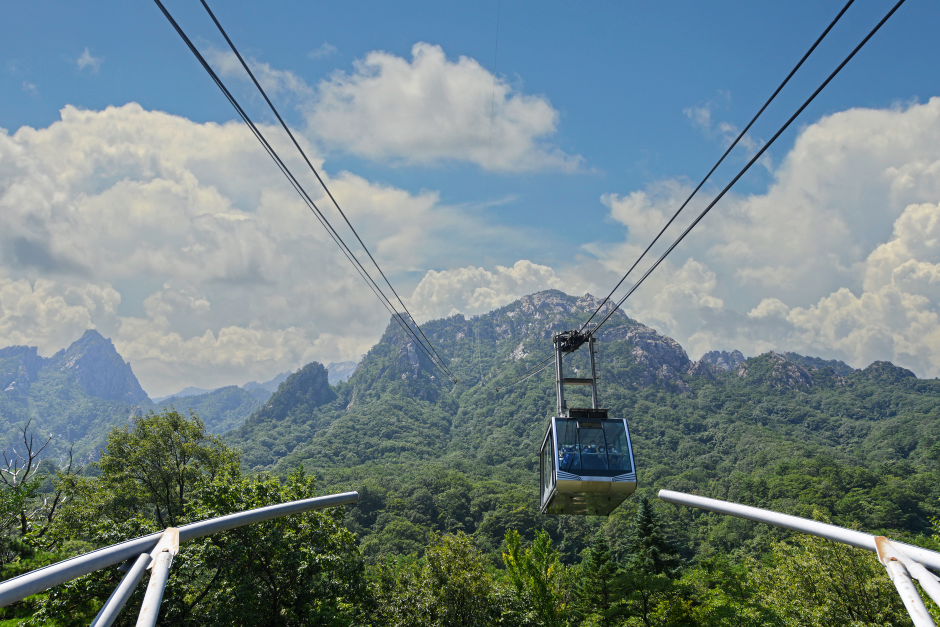
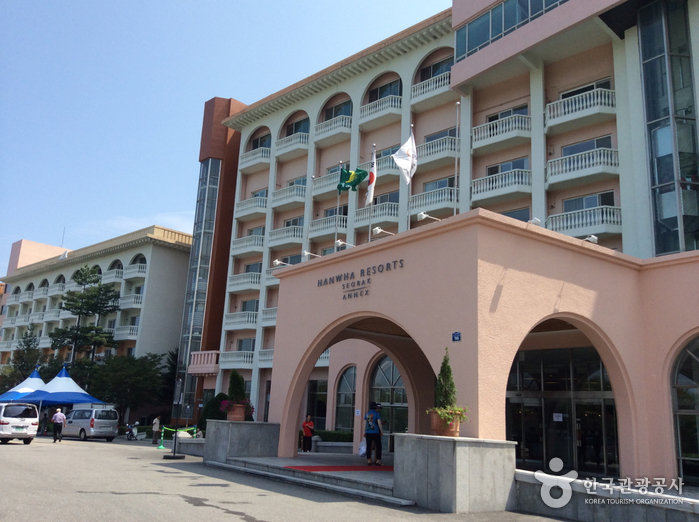
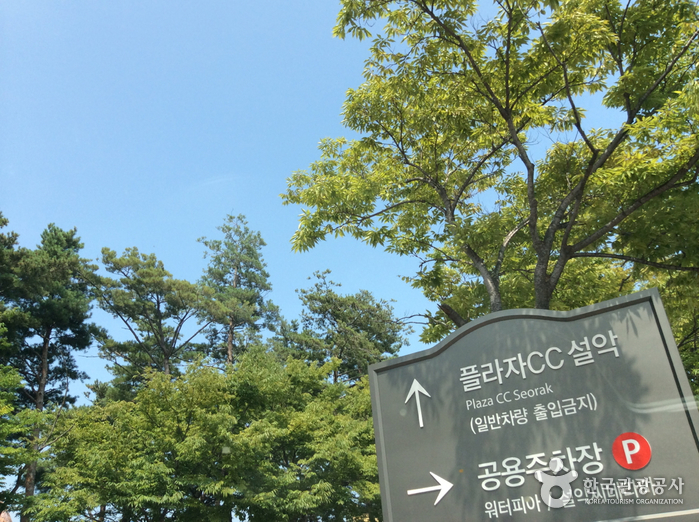
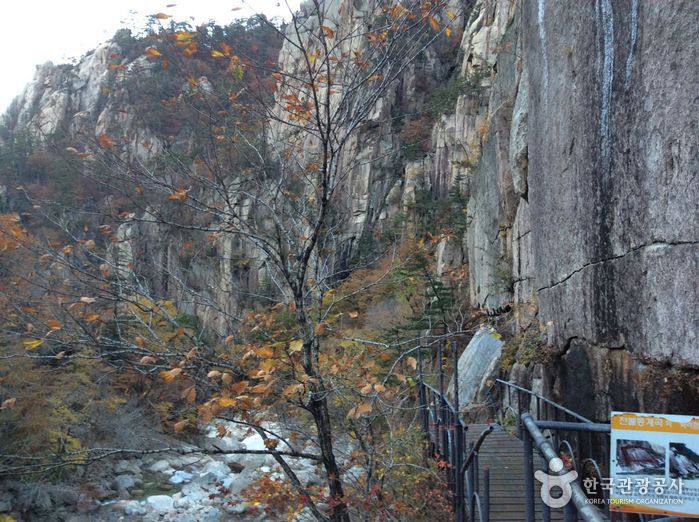
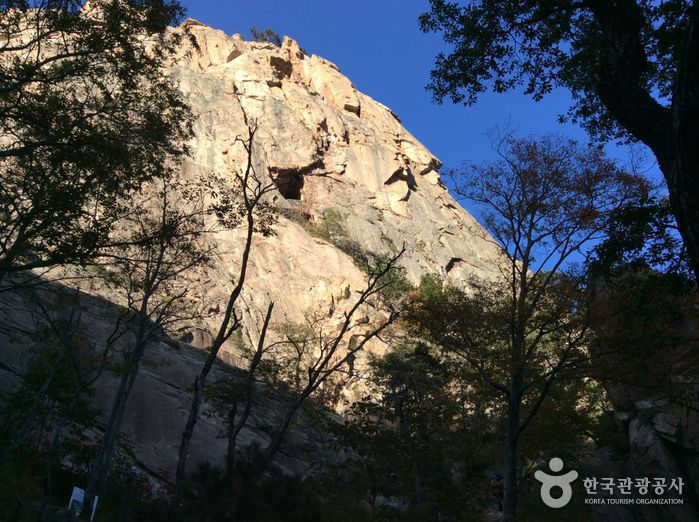
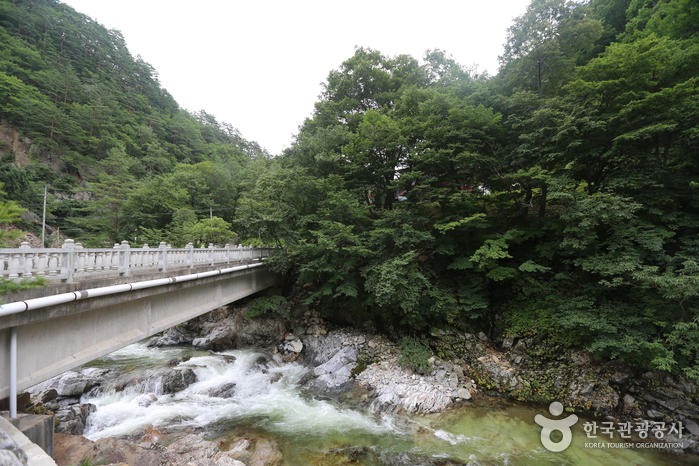
 English
English
 한국어
한국어 日本語
日本語 中文(简体)
中文(简体) Deutsch
Deutsch Français
Français Español
Español Русский
Русский